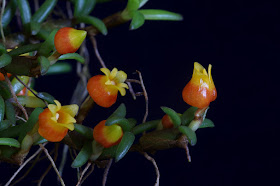Barbosella australis is a tiny creeping species with
paddle-shaped leaves and large flowers in proportion to the size of the
plant. The leaves are 1.5 cm and the flowers 2 cm. It blooms
for me in the autumn and is easy to grow, always blooming with an abundance of flowers. The name, australis, refers not to the country of origin - it is from Brazil - but to the fact that it comes from the southern parts of that country. The flowers are not very showy but are unusually shaped and colored and the genus is related to Masdevallia and Pleurothallis.
Saturday, December 26, 2015
Monday, December 21, 2015
Dendrobium hippocrepiferum
This unusual species is from New Guinea. I've just bloomed it for the first time and only one flower, so the photos are limited. The plant is a mass of thin growths with short fat leaves that remind me of some conifers. The flowers are less than 1 cm and are held "upside down" in comparison to most orchids, i.e., the lip is uppermost. Flowers like this that do not twist around before they open and that hold their lip uppermost are called non-resupinate. The species name, hippocrepiferum, means "horse-shoe carrying" and refers to the horseshoe-shaped and joined sepals (not really visible in these photos).
Wednesday, December 16, 2015
Paphiopedilum venustum and venustum album
I recently posted photos of Paphiopedilum venustum var. album and have posted before photos of the normal variety. Here are the two of them together for comparison. It is obvious that the album lacks any of the red or purple coloring of the normal variety. The plants and flowers are very similar in size, but the leaves of the album variety also lack any red or purple coloring. The species if from Bangladesh, India and Nepal.
Friday, December 11, 2015
Masdevallia glandulosa
Masdevallia glandulosa is an orchid species from Ecuador. Its
flowers are unique both on account of the tiny glandular hairs for which the plant
is named and on account of their strong clove scent. The plant will perfume a
whole room. I have several plants clones of this species and this has the largest flowers. They are 5 cm from tip to tip on a plant that is 10 cm tall. In my experience the plant prefers to be potted and likes
somewhat moister conditions and lower light than other Masdevallias.
Monday, December 7, 2015
Masdevallia hirtzii
Very typical of the section of Masdevallia to which it belongs (Saltatrices) with its brightly colored, tubular flowers, Masdevallia hirtzii is from Ecuador and Peru. It is a very small plant, only 8 cm tall, and produces an abundance of 4 cm flowers if well grown. It is supposed to be temperature tolerant but I grow my plant intermediate to cool in sphagnum moss in a net pot. It blooms faithfully for me every year in late autumn and winter.
Tuesday, December 1, 2015
Sigmatostalix uncinata
Sigmatostalix uncinata, from Ecuador, is a newly described species and is related to Oncidium. It has in fact recently been included in that genus. It is a small plant only 12 cm tall and looks like a fan of leaves with a small pseudobulb at the center of the leaves. It carries several flowers at a time on each flower spike and they continue to produce flowers for several months. The flowers are 2 cm and have a very prominent column which looks like a bird's head. The plant seems to do best for me mounted on a small piece of tree fern. There are around 70 species in the genus which ranges from Mexico to Brazil.
Wednesday, November 25, 2015
Mediocalcar decoratum
Mediocalcar decoratum is an unusual miniature, mat-forming
species from the highlands of New Guinea. It is cool growing and does well
either on a mount or in a pot, but needs room to ramble. The
individual growths are about 1 cm, have a thick fleshy stem and a fan of
four tiny fleshy leaves at the top. Each new growth begins near the
top of the previous growth, forming an ever-lengthening chain. The
flowers, 0.5 cm in size, come from the base of the growths and look like
tiny candy-corns. Though cool-growing the plant is very easy to grow and is very tolerant of different conditions.
Saturday, November 21, 2015
Paphiopedilum venustum album
I don't have many Paphiopedilums, but they are all in bloom or coming into bloom including this first bloom seedling of Paphiopedilum venustum var. album. I've included a picture of the normal variety for comparison, and it is obvious that this variety has not of the purple and red coloration of the other variety. It is a small plant with beautifully mottled foliage, though the foliage has none of the purple coloration either, and it is from Bangladesh, India and Nepal.
Paphiopedilum venustum
Monday, November 16, 2015
Trisetella gemmata
Nearly all my Trisetellas are in bloom at present and this is one of them, Trisetella gemmata from Colombia. It is fairly typical of the genus, both
in the color and size of the flowers and in plant size. The plant is a
cluster of narrow channeled leaves about 4 cm tall, and the rather
strange flowers are about 3 cm in size. It produces its flowers during
the winter and each flower spike produces a succession of 4-6 flowers.
The plant is from high altitudes and does best in cool
to cold temperatures with high humidity. I grow it mounted on a piece
of bark and water it nearly every day. Its name, gemmata, refers to the sparkling texture of the flowers which is very hard to capture in a photograph, and Trisetella, the genus name, refers to the three thread-like tails of the flower.





















































